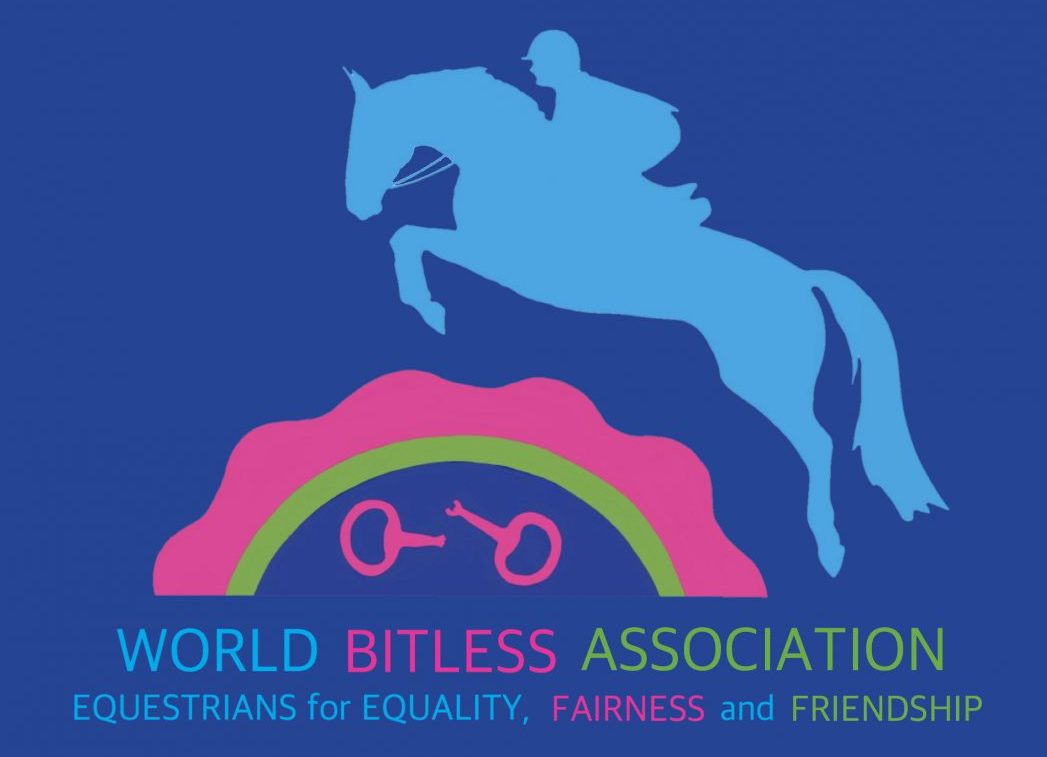BIT-INDUCED UPPER- AIRWAY OBSTRUCTION AS THE CAUSE OF PULMONARY EDEMA (‘BLEEDING’), CATASTROPHIC ACCIDENTS AND SUDDEN DEATH IN THE RACEHORSE:
A hypothesis for testing
Robert Cook[1]
A young and virile racehorse in the starting gate may, one minute later, be dead. What is it that could kill a horse so quickly? One way is bit-induced suffocation (Cook 2021). A second way is bit-induced cardiac arrest as here explained.
In man, cardiac arrest can be caused by a trigeminocardiac reflex (Chowdury and Schaller 2015). This is a reflex arc that connects the sensory nerve of the mouth and face (the trigeminal nerve) to the motor nerve controlling the heart (the vagus nerve). During mouth surgery in man, the anesthetist monitors the function of the heart and alerts the surgeon to any signs of this potentially fatal reflex being activated. Although the reflex is present in all mammals, its existence has been overlooked in veterinary medicine.
Yet, strictly speaking, bit use in the horse is intrusive surgery. It enables protracted, painful and repetitive surgical interventions to be carried out in a horse’s mouth, a highly sensitive body cavity. The word ‘surgery’ derives from a Greek word with the root meaning “a working with the hands” (Partridge 1958). For thousands of years, this standard operating procedure, with its claimed purpose of controlling the horse, has been carried out daily, without anesthesia, by riders of all ages and skills, using one or more blunt instruments manipulated two-handedly from a rein’s length distance when both rider and horse are in motion. In the racehorse, nerve pain-receptors on both sides of the head are often stimulated by two bits (a snaffle and a ring bit) and, quite often, by a noose tying the tongue to the lower jaw (a ‘tongue-tie’). In fact, a bit does not control a horse; quite the opposite. A bit is the most common cause of loss of control. Horses learn to resist the bit by bolting, bucking, rearing and by scores of other conflict behaviors (Cook and Kibler 2019).
The article has five objectives:
- To alert riders that use of a bit causes a horse pain. Ironically, this is something that, unconsciously, the rider already knows because pain generates unwanted behavior in the horse and this, in turn, increases rider’s subconscious awareness of the risks of riding (Cook and Kibler 2022). Unfortunately, riders often fail to make the connection between their increasing sense of anxiety when riding and the bit as its most likely cause.
- To emphasize that a bit breaks the lip seal and so prevents a running horse from stabilizing its throat airway prior to fast exercise (Cook 2021). Soft palate instability causes suffocation and this, in turn, causes negative pressure pulmonary edema (‘waterlogging’ of the lungs) – two signs of which are pulmonary hemorrhage (‘bleeding’) and sudden death.
- To explain how the bit could also cause sudden death by reflex stimulation of the vagus nerve, resulting in cardiac arrest. (Cook 1999, 2002, 2016, 2017, 2018, 2019a, 2019b, 2021, Cook et al 1988).
- To describe several additional steps for necropsy examinations on sudden death in the racehorse that could reveal evidence of suffocation but which are not part of standard protocols currently in use.
- To recommend bit-free trials for all equestrian sports.
For c.30 years, equine necropsy examinations have been mandated by many racing jurisdictions for all sudden deaths and catastrophic accidents. No consensus has been reached on their cause.
Since 2000, bit-free horsemanship has been increasingly adopted by recreational riders. In a bit-free trial of 66 horses used for recreational riding, removal of the bit reduced the number of bit-induced unwanted behaviors in the population by 87% (Cook and Kibler 2019). The study did not, of course, provide any data on sudden death. But, if it is the stress imposed by the conditions of competition that cause ‘bleeding’, catastrophic accidents and sudden death, this is perhaps a reason for considering if, by lessening the stress, the incidence of these additional problems can also be reduced?
As bit-free competition is not permitted in most equestrian sports, comparisons of bitted and bit-free performance are ruled-out. Where a comparison is possible, as in bitted and bit-free dressage, the data is not currently being collected. However, the rationale for bit-free equestrian sport is not dependent on showing that the bit is an impediment to performance and sometimes fatal. It is enough that a bit has been shown to be a cause of pain (Cook 2021, Cook and Mills 2009, Cook and Kibler 2019, Mellor 2020 a, b, c, Mellor and Beausoleil 2017, 2020)
Sadly, no discussion of rule changes to permit bit-free competition have yet been announced. Even when their need is recognized, it will take time for such rules to be introduced. In the meantime, the reality of bit-induced pain, suffocation and pulmonary edema, together with the possibility of bit-induced cardiac arrest, is not being addressed and the social licence of equestrian sport is being increasingly questioned.
When rules were first drawn-up for equestrian sports, the need for a metal bit was accepted without question, it having been the custom since the Bronze Age. As a result, mandated-bit rules or, as in racing, the implicit requirement for bit use, has shielded the bit from being questioned until quite recently (Cook 1999). From monitoring bit-free recreational riding over the last 24 years, and from three trials (Cook and Mills 2009, Cook and Kibler 2019, 2022), it is my experience that bit-free horsemanship improves control and reduces conflict behaviour and accidents.[2] It seems reasonable to predict that these same benefits will emerge in racing if and when racehorses can breathe freely and are not in pain.
THE MOUTH-HEART CONNECTION; a trigeminocardiac reflex
In man, stimulation of a trigeminocardiac reflex can cause cardiac arrhythmia, cardiac arrest, low blood pressure, cessation of breathing and sudden death (Chowdury and Schaller 2015). The effect of such a reflex in mammals was first described in 1869, by Florian Kratschmer, a graduate of medicine doing physiological research on cats and rabbits in Vienna. Since then, work by Chowdury and others (2015) has revealed specific examples of its expression; a diving reflex, an ‘eye-heart’ reflex, and an ‘eye-breathing’ reflex – each with potentially fatal consequences in man.
A bit or tongue-tie will trigger two types of signals; sensory and parasympathetic. Sensory signals of touch and pain are transmitted via the trigeminal nerve to the brain for processing and result in movement of one or more parts of the body. Parasympathetic signals are transmitted via the vagus nerve. In the horse, as in man, the trigeminal nerve is intimately linked to the vagus nerve. In Figure 1, visualize sensory filaments of the vagus interlaced with those of the trigeminal, providing a direct nervous pathway from the bit to the heart and lungs; a conceivable cause of cardiac arrhythmia (e.g., atrial fibrillation), cardiac arrest, low blood pressure, cessation of breathing and sudden death.
[1] Professor of Surgery Emeritus, Cummings School of Veterinary Medicine, Tufts University, Massachusetts, USA bob.cook@tufts.edu
[2] Full disclosure: From 2000 to 2016, I owned a company that sold a bit-free bridle.
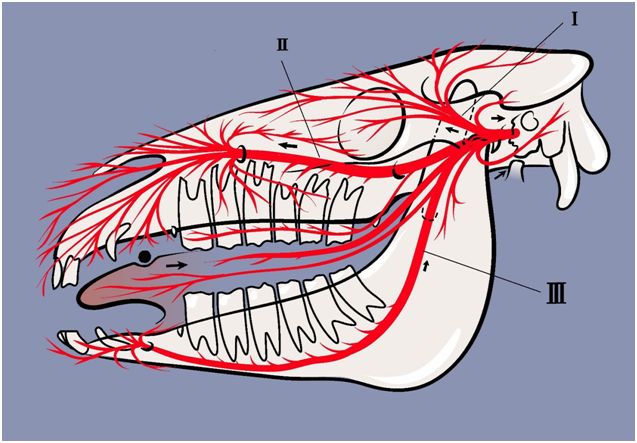
In the bitted horse, a trigeminocardiac reflex could be stimulated, in particular, via the third branch of the nerve (the mandibular nerve). This supplies sensation to the bars of the mouth, lower jaw teeth, tongue, mucous membranes of the mouth and the lower lip (Fig.1). These are all regions exposed to bit damage. The second branch (the maxillary nerve) supplies a smaller but still significant range of tissues damaged by the bit, i.e., the roof of the mouth, mucous membranes and upper lip. It also serves the soft palate and this raises the possibility of the bit triggering referred pain in the throat.
In addition to the mouth-heart connection, several other features about bit-stimulated pain are of note:
- A bit stimulates two nerves, the mandibular and maxillary nerves, each with a large number of potential trigger points.
- It may do this on both sides of the head; simultaneously and repeatedly.
- The showers of pain are repeated on a random basis for the duration of any one exercise period.
- The whole sequence is repeated the next day and every day for the remainder of a horse’s working life.
- Using a ballistic metaphor, it might be said that a bit functions like a repeater pistol with a limitless supply of high caliber bullets
- Trigeminal neuralgia in man is widely recognized as one of the most severe forms of pain. Little wonder that a bitted horse is touchy about its mouth and inclined to be head shy. Trigeminal-mediated headshaking in the horse is common and often career-ending.
- As a horse does not develop its permanent dentition until the age of five, a racehorse is ‘teething’ throughout the critical years of its career and at high risk of developing hypersensitivity of the trigeminal nerve.
Bit-induced pressure generated by the rider or driver is one of two ways in which a trigeminocardiac reflex might be stimulated. A second way is for the pressure to be generated by the horse. Rein tension has the effect of placing the bit between the cheek teeth. A horse that defends itself by ‘grabbing-the-bit’, could conceivably trigger the reflex.
ATRIAL FIBRILLATION
In a review of atrial fibrillation in horses (Kjeldsen et al 2022), the authors note that this form of cardiac arrhythmia is common in Thoroughbred racehorses and even more common in Standardbred racehorses. Clinical signs are ‘poor performance’ and the sudden loss of performance during a race. Within a group of poor performing racehorses, atrial fibrillation was present in one third. Sudden death was not listed and the authors made no reference to a trigeminocardiac reflex. Nevertheless, atrial fibrillation is consistent with it being caused by the existence of such a reflex or by stimulation of vagal nerve receptors in the edematous lung. As bit-induced mouth pain is most severe in harness racing, it is also consistent with the above report that atrial fibrillation is most common in the Standardbred.
DISCUSSION
The behaviour of a horse bridled with a bit is not that of a normal horse. It’s the behaviour of a horse reacting to one or more oral foreign bodies. Sixty-nine bit-induced pain behaviours have been documented in recreational riding (Cook and Kibler 2019). Others may be identified in equestrian sport when bit-free comparisons become possible.
The racehorse will be especially vulnerable to the effects of a mouth-heart reflex because of the intensity with which its equipment stimulates the trigeminal nerves. In a race, it is standard practice for a jockey to ’rate’ a horse by rein tension for all except the final stretch, i.e., causing suffocation by poll flexion, over and above the suffocation caused by a bit preventing a running horse from sealing its lips. The horse is an obligate nose-breather. A free-roaming horse in the wild runs with its mouth closed, lips sealed, a sub-atmospheric pressure in its oral cavity, and its soft palate firmly clamped by suction pressure to the root of the tongue (Cook 2021). A bit breaks the lip seal and air in the mouth releases the soft palate from its adherence to the tongue. Soft palate instability obstructs the upper airway at the level of the throat; hence the etymological origin of the verb ‘to suffocate’ (to choke someone by placing one’s hands under their throat).
Once a racehorse has ‘passed the wire’, the ‘mouth-heart’ connection is re-established with even greater intensity if a jockey ‘pulls-up’ the horse (Figure 2). Not only is mouth-pain intensified but, due to additional poll flexion, so also is the degree of suffocation. The added pain and suffocation beyond the wire may be ‘the last straw’ for a bitted horse that is already hypoxemic (short of oxygen) and exhausted, so explaining the occurrence of stumbling, falls and catastrophic accidents in the immediate post-race period.
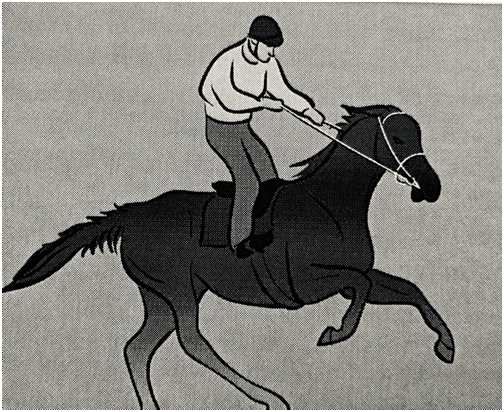
Though sudden death ‘after the wire’ is not the most common pattern for its occurrence, it does represent a distinct pattern. The death of EIGHT BELLES is an example (Fig 3). Placing second in the 2018 Kentucky Derby, she fell one furlong past the wire, incurring compound fractures of the fetlock in both front legs[1].
[1] In man, pulmonary edema causes intense chest pain and a sense of drowning.
In man, pulmonary edema causes intense chest pain and a sense of drowning.
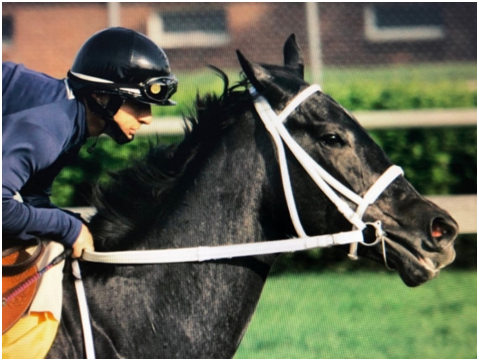
Evidence from harness horse racing (Hellings et al 2022), adds to the data on ‘beyond the wire’ occurrence of sudden death. Seven of 41 ‘sudden athletic deaths’ occurred before the start of the race, 14 during the race, and 20 immediately after the race. All of the 27 deaths before and after the race (66%) would have occurred at times when rein tension was high.
In harness racing, the long lines enable a driver, leaning back with his feet on the dashboard, to exert an even greater pressure on a horse’s mouth than does a rider. This, together with the severity of the equipment used (a driving bit, often also a check bit and sometimes a running martingale), could explain the 49% incidence of death ‘after the wire’.
The primary cause of death in 30 of the harness horses was considered to be “acute circulatory collapse because of suspected cardiac, pulmonary failure, or both.” Again, “all 30 horses had varying degrees of pulmonary hemorrhage, edema, and congestion.” These findings are consistent with the hypothesis that ‘bleeding’ is caused by bit-induced upper airway obstruction and suffocation (Cook et al 1998, Cook 2021, Cook and Strasser 2003). Suffocation causes negative pressure pulmonary edema as determined by a law of aerodynamics (Poiseuille’s Law). Because horses have long necks and, therefore, long windpipes, their lungs are especially vulnerable to obstruction of the upper airway at the level of the throat.
Finally, it should be noted that sudden death in racehorses is not something that occurs only in a race. XYJet and Medina Spirit are examples of two horses that died after completing a training ‘workout’ when they were being pulled-up.
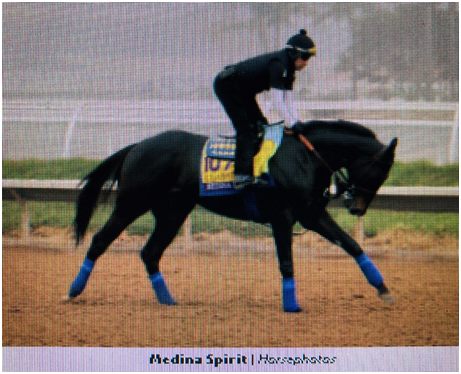
Figure 4. Illustrating the degree of poll flexion and upper airway obstruction that can be caused when a rider stands in the stirrups to ‘pull a horse up’.
Medina Spirit Necropsy Report to Be Released Friday (thoroughbreddailynews.com)
SUMMARY SUGGESTIONS
The bit is indicted as a common cause of pain and unwanted behavior, lameness under saddle, suffocation, poor performance and a number of common diseases other than ‘bleeding’, catastrophic accidents and sudden death, e.g., palatal instability, dorsal displacement of the soft palate, epiglottal entrapment, headshaking, ‘scabbard’ trachea and lameness under saddle (Cook 2021). A bitted horse is a disabled horse; penalized both physically and mentally.
Under the proposed Horse Integrity and Safety Act (HISA 2020), a bit will contravene section 1206b (1) which states that “Covered horses should compete only when they are free from the influence of medications, other foreign substances and methods that affect their performance.“ Similarly, a bit will contravene section 1206b (2) “Covered horses that are injured or unsound should not train or participate in covered races …”
Exercise-induced pulmonary haemorrhage is a misleading and unhelpful name. It is not the exercise that causes ‘bleeding’ but the suffocation during exercise, i.e., not so much EIPH as SIPH. My suggestion is that veterinary medicine should adopt the name as used for what is essentially the same condition in human medicine, i.e., negative pressure pulmonary edema (Deepika et al 1997, Bhaskar and Fraser 2011).[1]
Sudden death in the horse is the consequence of a management problem and it requires a management solution. Essentially, it is an equipment problem and a procedure under HISA that affects performance. The problem can, I suggest, be solved by repealing mandated-bit rules and, for horse racing, withdrawing the implicit requirement of bit usage. It is time to discard a Bronze Age custom.
Governing bodies are encouraged to sponsor bit-free trials for all equestrian sport from Pony Club upwards. If the results are as I expect them to be and the trials are followed by the necessary rule changes to allow bit-free choice, this will improve the welfare of the horse, the safety of the rider, and support a continuation of the social licence for equestrian sport.
Bit-free dressage provides an opportunity for comparing bitted with bit-free performance [2]. The Royal Dutch Equestrian Federation, for example, have opened-up this possibility in recent years by allowing bit-free competition in all classes short of Grand Prix.
In the USA and other countries, the rules of racing do not mandate use of the bit. Nevertheless, use of the bit is implicitly required. However, as suitability of equipment is a matter for decision by the stewards, this could allow bit-free racing to be introduced on a case-by-case basis, e.g., after it has been demonstrated to the stewards, by a training gallop or a timed workout, that a horse is under control when bit-free.
Undoubtedly, there are many possible ways that change could be introduced. Each jurisdiction, recognizing that change is needed, will consider their options.
RECOMMENDATIONS FOR NECROPSY PROTOCOLS
Acting on the probability that sudden deaths and catastrophic accidents in horse racing are caused by a combination of bit-induced pain and suffocation, it follows that necropsy protocols should include steps for discovering evidence of these problems. Additional steps are suggested as follows:
- On admittance, the cadaver should be accompanied by a written case record, with as much information as possible about the circumstances of the death. All bits, tongue ties and other harness items will have been removed before a cadaver is delivered, so the record should include a list of the equipment used.
- The bars of the mouth and teeth to be radiographed for bit-induced damage (Cook 2011).
- Endoscopy of the respiratory tract. Was there, for example, any evidence of epiglottal entrapment or tracheal deformity?
- Radiography of the windpipe in the neck to detect bit-induced deformities (‘scabbard trachea’).
- As recurrent laryngeal neuropathy (paralysis or partial paralysis of the larynx) is common in the Thoroughbred and a cause of suffocation[3], examination of the larynx to include a search for evidence of muscle atrophy.
- In my experience, deformity of the trachea in the horse is a common postmortem finding and represents permanent change following repeated dynamic episodes of bit-induced airway obstruction at exercise (Figure 4). This may be overlooked if the larynx and trachea are opened, with a longitudinal midline incision through its soft roof, as is standard practice. Serial transverse sections are recommended. In a slaughterhouse survey of windpipes from 51 off-the-track Thoroughbreds (Smith, B.J. 1991, Personal Communication), all horses were found to exhibit varying degrees of dorso-ventral flattening (‘scabbard trachea’), particularly at the entrance to the chest. Twenty-two of 47 windpipes (47%) were flattened throughout their length
- After an examination of the lips, the soft tissues of the cheek to be removed to permit palpation of the bars of the mouth and an examination of the tongue and teeth for bit damage.
[1] In human medicine, the name post-obstructive pulmonary edema or POPE is also used (https://doi.org/10.1016/S1089-9472(03)00183)
[2] Judging standards will need to be reviewed (Taylor 2022)
[3] This neuropathy may be caused by bit-induced hypoxemia, though we shall never discover this until mandatory-bit rules are repealed
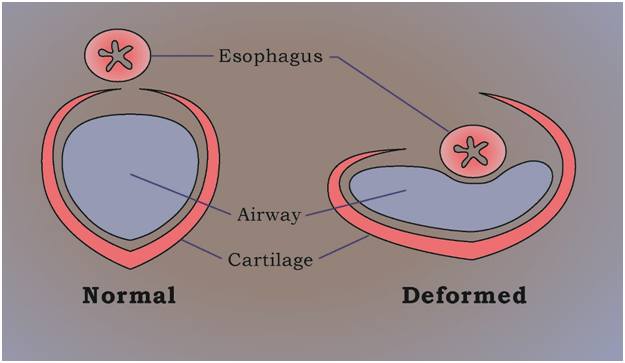
As I understand it, some racing jurisdictions disallow knowledge of the clinical history to be included as evidence, requiring pathologists to confine themselves to what they see. Evidence from video footage of the race is not utilized. Oversight of the report may disallow definitive statements about the cause of death. Such a policy on the part of a jurisdiction may be prompted by an understandable wish to avoid litigation. Whether or not this constraint applies, the reality is that in a high proportion of necropsy reports, the cause of death is undetermined. This may seem to negate the purpose of the necropsy program but not so. A single report on a named horse is not data. For any definitive assessment on cause, collective and anonymous studies are needed such as that by Lyle et al (2011).
Two existential questions now arise. Can horse racing afford the time for an updated necropsy program to be completed on a statistically significant number of additional sudden deaths? Or does some more immediate welfare-and-safety enhancing solution need to be tested, namely bit-free trials?
Heart rate monitoring is recommended for obtaining data on both the trigeminocardiac reflex in the horse and atrial fibrillation.
CONCLUSIONS
In human medicine, negative pressure pulmonary edema (NPPE) is a rare, life-threatening emergency caused by upper airway obstruction that requires immediate intensive care. In the racehorse, upper airway obstruction and ‘bleeding’ (i.e., NPPE) is extremely common and caused by the currently required equipment. Management by prevention is imperative and requires the cessation of a Bronze Age standard practice. Horseracing will go the way of greyhound racing unless administrations take the necessary first steps to allow bit-free racing. Once trainers recognize the bit-free benefits of improved performance, safety and welfare for horse and rider, and the enhanced public perception of racing, use of bits and whips will be the items that die out, not racing itself. In effect, a bitted rein is a whip by another name.
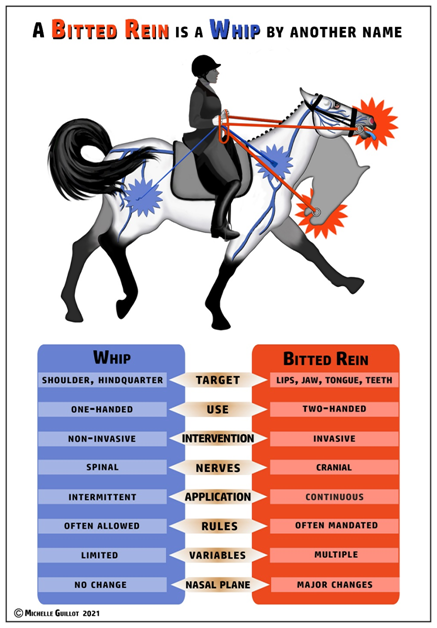
FURTHER READING
Bhaskar, B.; Fraser, J.F. (2011): Negative pressure pulmonary oedema revisited: Pathophysiology and review of management. Saudi J. Anaesth. 5, 308–313.
Chowdhury T and Schaller B.J. (2015): Trigeminocardiac Reflex. Elsevier, Amsterdam, London, Tokyo
Chowdhury, T.; Mendelowith, D.; Golanov, E.; Spiriev, T.; Arasho, B.; Sandu, N.; Sadr-Eshkevari, P.; Meuwly, C.; Schaller, B. (2015): Trigeminocardiac reflex: The current clinical and physiological knowledge. J. Neurosurg. Anesthesiol. 27, 136–147.
Cook, W.R. (1999): Pathophysiology of bit control in the horse. J vet. eq. sci., 19, 196-204.
Cook, W.R. (2002): Bit-induced asphyxia in the horse: Elevation and dorsal displacement of the soft palate at exercise. J vet. eq. sci. 22, 7-14.
Cook, W.R, (2011): Damage by the bit to the equine interdental space and second lower premolar. Equine Vet. Educ. 2011, 23(7), 355-360. DOI:10.1111/j.2042-3292.2010.00167.x.
Cook, W.R. (2014): A hypothetical, aetiological relationship between the horse’s bit, nasopharyngeal asphyxia and negative pressure pulmonary oedema. Equine Vet. Educ. 26 (7), 381-389.
Cook, W.R (2016): Bit-induced asphyxia in the racehorse as a cause of sudden death; a hypothesis. Equine vet. educ. 28, 405-409.
Cook, W.R. (2017): Bitted mouths cause waterlogged &‘bleeding’ lungs: Racehorses need management, not medication WaterlogBleeding.pdf (bitlessbridle.com)
Cook, W.R. (2018): Unintended consequences in preparing the ‘big horse’ for the ‘big race’. Horsetalk, 9 Dec.; www.horsetalk.co.nz/2018 [Accessed online on 12 March 2022]
Cook, W.R (2019a) Horsemanship’s ‘elephant-in-the-room’ – The bit as a cause of unsolved problems affecting both horse and rider
[Accessed online 1 February 2022]
Cook, W.R. (2019b): Man bites horse. Weltexpress, Germany September 8, https://en.weltexpress.info/2019/09/08/human-biteshorse/
Cook, W.R (2021): Pain-free Horsemanship
https://en.weltexpress.info/2021/09/29/pain-free-horsemannship/
[Accessed online on 31 January 2022]
Cook, W.R. Williams, R.M.; Kirker-Head, C.A.; Verbridge, D.J (1988): Upper airway obstruction (partial asphyxia) as the possible cause of exercise induced pulmonary hemorrhage in the horse: a hypothesis. J. eq. vet. sci. 8,11-26.
Cook, W.R; Strasser, H. (2003): Metal in the mouth: The abusive effects of bitted bridles. Sabine Kells, Qualicum Beach, BC, Canada.
Cook, W.R.; Mills, D.S. (2009): Preliminary study of jointed snaffle vs. crossunder bitless bridles: Quantified comparison of behaviour in four horses. Equine Vet. J., 41, 827-830. https://doi.org/10.2746/042516409X472150 [Accessed online on 15 October 2020]
Cook, W.R.; Kibler, M. (2019): Behavioural assessment of pain in 66 horses, with and without a bit. Equine Vet. Educ. 31(10), 551-560. doi.org/10.1111/eve.12916 [Accessed online on 29 June 2020]
Cook, W.R.; Kibler, M. (2022): Unpublished data
Deepika, K.; Barrocas, Q.M.; Fonseca, J.J.; Bikasi, G.B. (1997): Negative pressure pulmonary edema after acute upper airway obstruction. J. Clin. Anaesth., 9, 403–408. [CrossRef]
HISA (2020): Horse Integrity and Safety Act. www.horseracingintegrity.com/pdf//HISA finalbill.pdf
Hellings, I.R; Skjerve, E:Karlstam, E: Valheim, M; Ihler, C.F; Fintl, C (2022): Racing-associated fatalities in Norwegian and Swedish harness racehorses: Incidence rates, risk factors, and principal postmortem findings. Journal of Veterinary Internal Medicine
https://doi.org/10.1111/jvim.16364
Kjeldsen, S.T.; Nissen, S.D.; Buhl, R.; Hopster-Iversen, C: Paroxysmal Atrial Fibrillation in Horses: Pathophysiology, Diagnostics and Clinical Aspects. Animals 2022, 12, 698. https://doi.org/10.3390/ani12060698
Lyle, C.H, Uzal F. A, McGorum, B.C, Aida. H, Blissitt, K.J, Case, Charles, J.T, Gardner, I, Horadagoda, N, Kusano, K, Lam, K, Pack, J.D, Parkin, T.D, Slocombe, R.F, Stewart B.D, and Boden, L.A. Sudden death in racing Thoroughbred horses: An international multicentre study of post mortem findings. Equine vet. J. (2011) 43 (3) 324-331
doi: 10.1111/j.2042-3306.2010.00164.
Mellor, D.J. (2020a): Mouth pain in horses: Physiological foundations, behavioural indices, welfare implications and a suggested solution. Animals,10(4), 572; https://doi.org/10.3390/ani10040572
Mellor, D.J. Bit Blindness. (2020b): VetScript, 33(9), 32-34.
Mellor, D.J (2020c): News and Views – A Bit of an Issue 3: D. Mellor’s response to letters objecting to his Bit Blindness article [Mellor, D. VetScript, 33(9), 32-34]. VetScript 2020c, 33(12), 7.
Mellor, D.J.; Beausoleil, N.J. (2017): Equine welfare during exercise: An evaluation of breathing, breathlessness and bridles. Animals, 7(6), 41
Mellor, D.J. and Beausoleil, N.J. (2020): Moving beyond a problem-based focus on poor welfare towards creating opportunities to have positive welfare experiences. In: Mental Health and Well-being in Animals, 2nd Edition (Ed. Franklin D. McMillan), CAB International, Wallingford, UK, Ch 5, pp 50-66.
Partridge, E (1958). Origins: A short etymological dictionary of modern English. The Macmillan Company, New York.
Smith, B.J. 1991, Personal Communication
Taylor, J (2022): I can’t watch anymore. The case for dropping Equestrian from the Olympic Games: An open letter to the International Olympic Committee. Epona Media, Copenhagen
